Analysing Barriers and Strategies for Effective Communication
VerifiedAdded on 2022/12/30
|8
|1278
|35
Report
AI Summary
This report provides a comprehensive overview of organisational communication, emphasizing its crucial role in achieving organisational success. It delves into the various channels and types of communication, highlighting the importance of clear and effective information flow. The report identifies several barriers to communication, including lack of transparency, poor listening skills, conflicts, language barriers, lack of eye contact, and dissatisfaction. Furthermore, it proposes strategies to overcome these barriers, such as active listening, consistent messaging, feedback mechanisms, appropriate language use, and transparency. The conclusion underscores the significance of effective communication as a cornerstone for organisational growth and goal attainment. The report also provides references to relevant books and journals to support its findings.
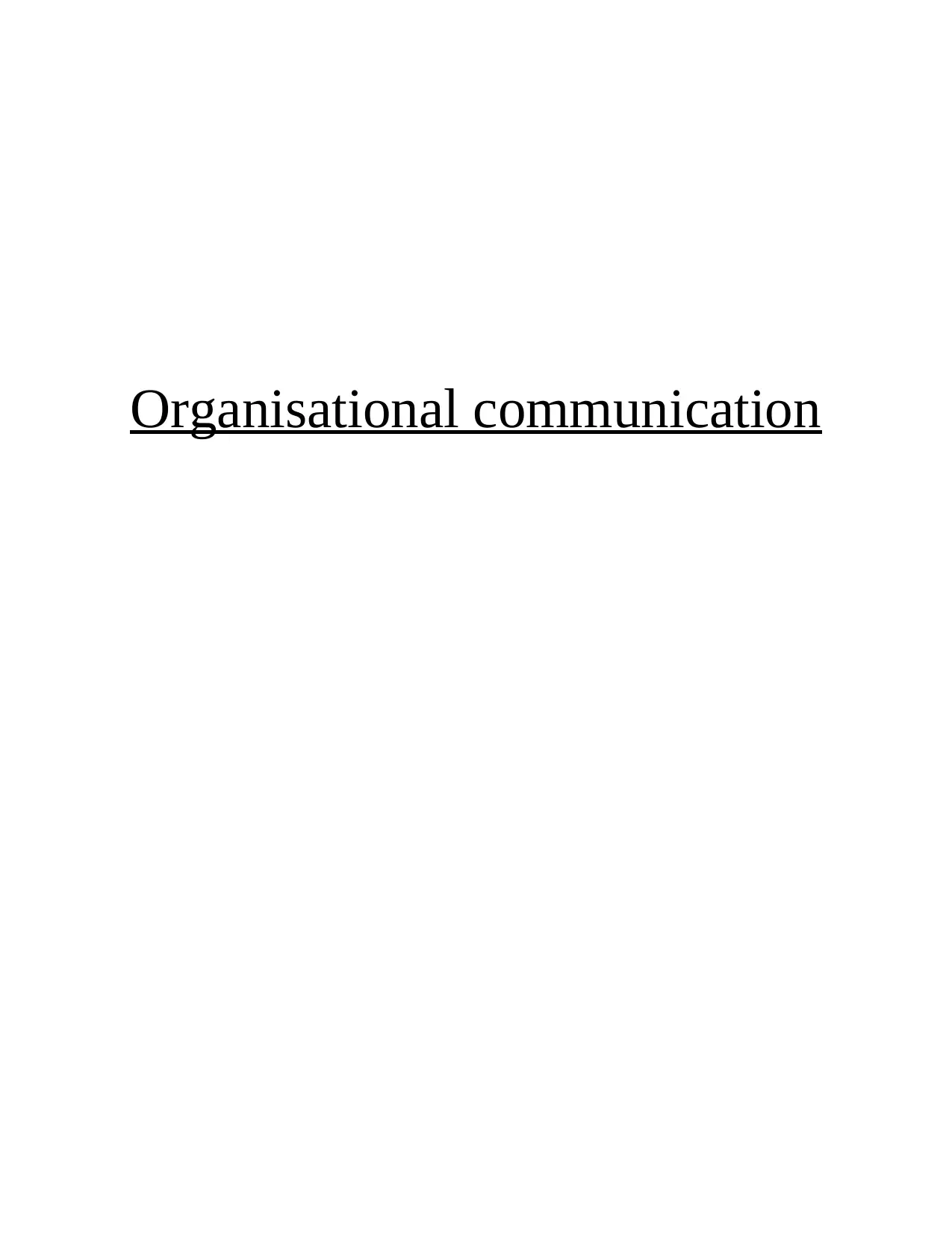
Organisational communication
Paraphrase This Document
Need a fresh take? Get an instant paraphrase of this document with our AI Paraphraser
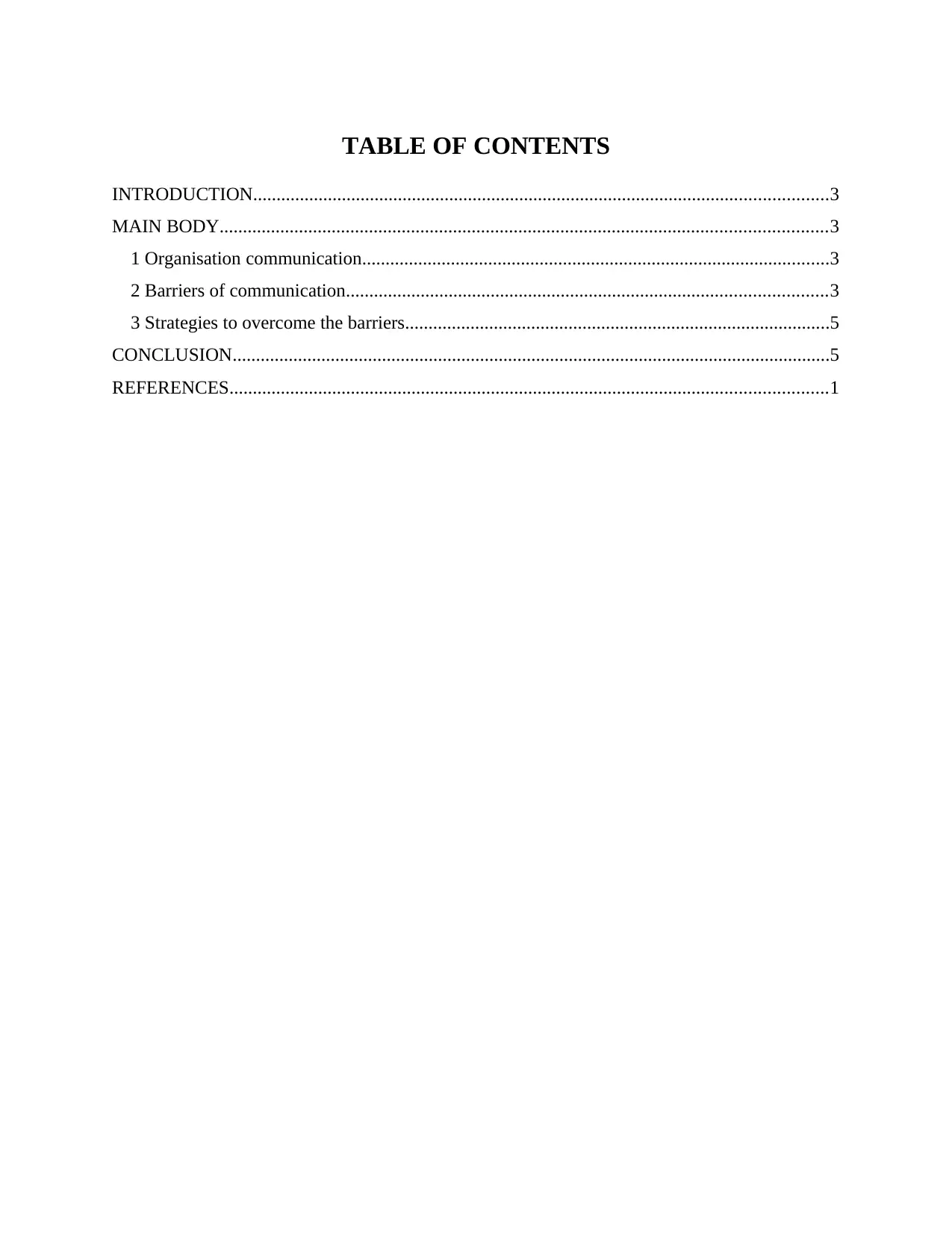
TABLE OF CONTENTS
INTRODUCTION...........................................................................................................................3
MAIN BODY..................................................................................................................................3
1 Organisation communication....................................................................................................3
2 Barriers of communication.......................................................................................................3
3 Strategies to overcome the barriers...........................................................................................5
CONCLUSION................................................................................................................................5
REFERENCES................................................................................................................................1
INTRODUCTION...........................................................................................................................3
MAIN BODY..................................................................................................................................3
1 Organisation communication....................................................................................................3
2 Barriers of communication.......................................................................................................3
3 Strategies to overcome the barriers...........................................................................................5
CONCLUSION................................................................................................................................5
REFERENCES................................................................................................................................1
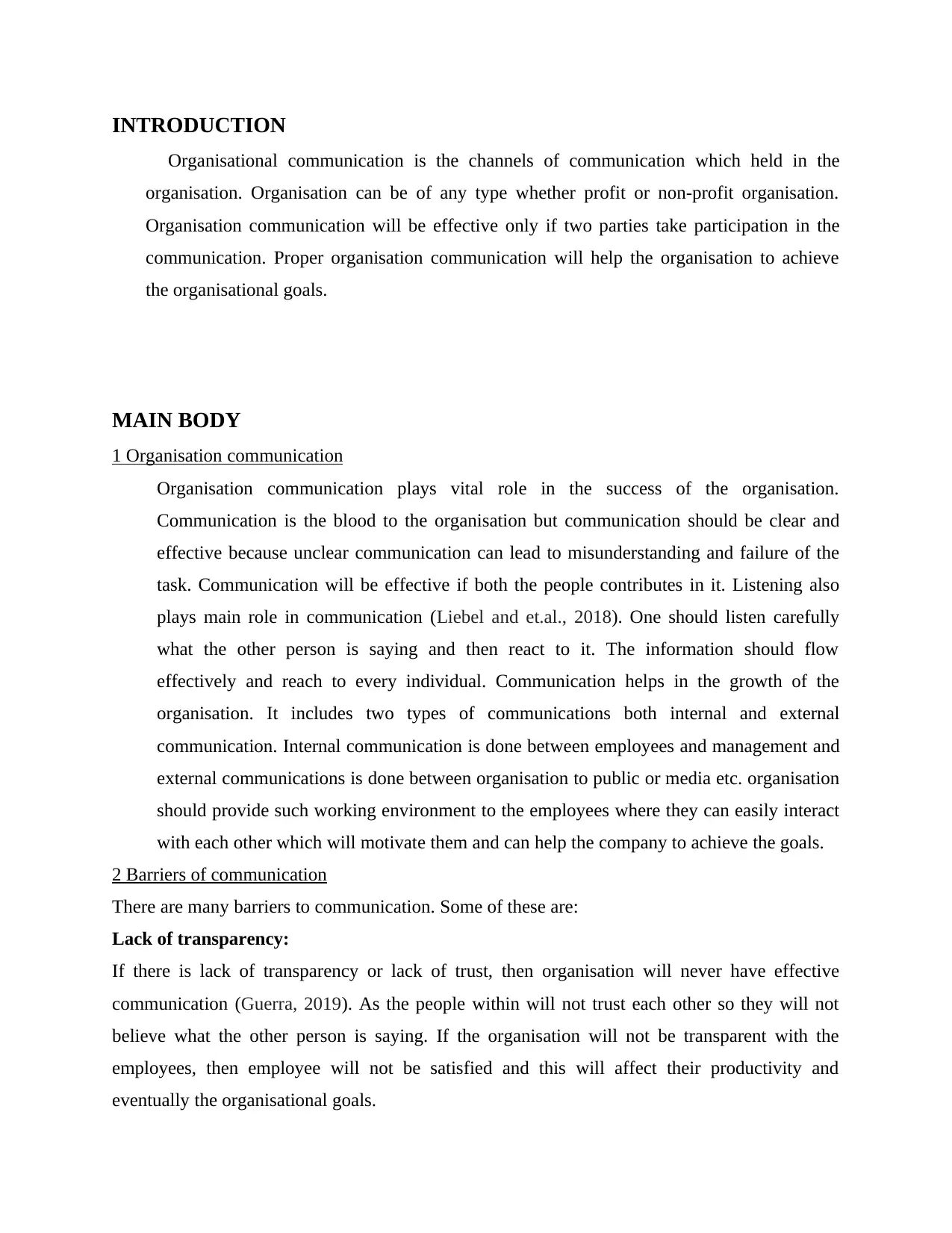
INTRODUCTION
Organisational communication is the channels of communication which held in the
organisation. Organisation can be of any type whether profit or non-profit organisation.
Organisation communication will be effective only if two parties take participation in the
communication. Proper organisation communication will help the organisation to achieve
the organisational goals.
MAIN BODY
1 Organisation communication
Organisation communication plays vital role in the success of the organisation.
Communication is the blood to the organisation but communication should be clear and
effective because unclear communication can lead to misunderstanding and failure of the
task. Communication will be effective if both the people contributes in it. Listening also
plays main role in communication (Liebel and et.al., 2018). One should listen carefully
what the other person is saying and then react to it. The information should flow
effectively and reach to every individual. Communication helps in the growth of the
organisation. It includes two types of communications both internal and external
communication. Internal communication is done between employees and management and
external communications is done between organisation to public or media etc. organisation
should provide such working environment to the employees where they can easily interact
with each other which will motivate them and can help the company to achieve the goals.
2 Barriers of communication
There are many barriers to communication. Some of these are:
Lack of transparency:
If there is lack of transparency or lack of trust, then organisation will never have effective
communication (Guerra, 2019). As the people within will not trust each other so they will not
believe what the other person is saying. If the organisation will not be transparent with the
employees, then employee will not be satisfied and this will affect their productivity and
eventually the organisational goals.
Organisational communication is the channels of communication which held in the
organisation. Organisation can be of any type whether profit or non-profit organisation.
Organisation communication will be effective only if two parties take participation in the
communication. Proper organisation communication will help the organisation to achieve
the organisational goals.
MAIN BODY
1 Organisation communication
Organisation communication plays vital role in the success of the organisation.
Communication is the blood to the organisation but communication should be clear and
effective because unclear communication can lead to misunderstanding and failure of the
task. Communication will be effective if both the people contributes in it. Listening also
plays main role in communication (Liebel and et.al., 2018). One should listen carefully
what the other person is saying and then react to it. The information should flow
effectively and reach to every individual. Communication helps in the growth of the
organisation. It includes two types of communications both internal and external
communication. Internal communication is done between employees and management and
external communications is done between organisation to public or media etc. organisation
should provide such working environment to the employees where they can easily interact
with each other which will motivate them and can help the company to achieve the goals.
2 Barriers of communication
There are many barriers to communication. Some of these are:
Lack of transparency:
If there is lack of transparency or lack of trust, then organisation will never have effective
communication (Guerra, 2019). As the people within will not trust each other so they will not
believe what the other person is saying. If the organisation will not be transparent with the
employees, then employee will not be satisfied and this will affect their productivity and
eventually the organisational goals.
⊘ This is a preview!⊘
Do you want full access?
Subscribe today to unlock all pages.

Trusted by 1+ million students worldwide
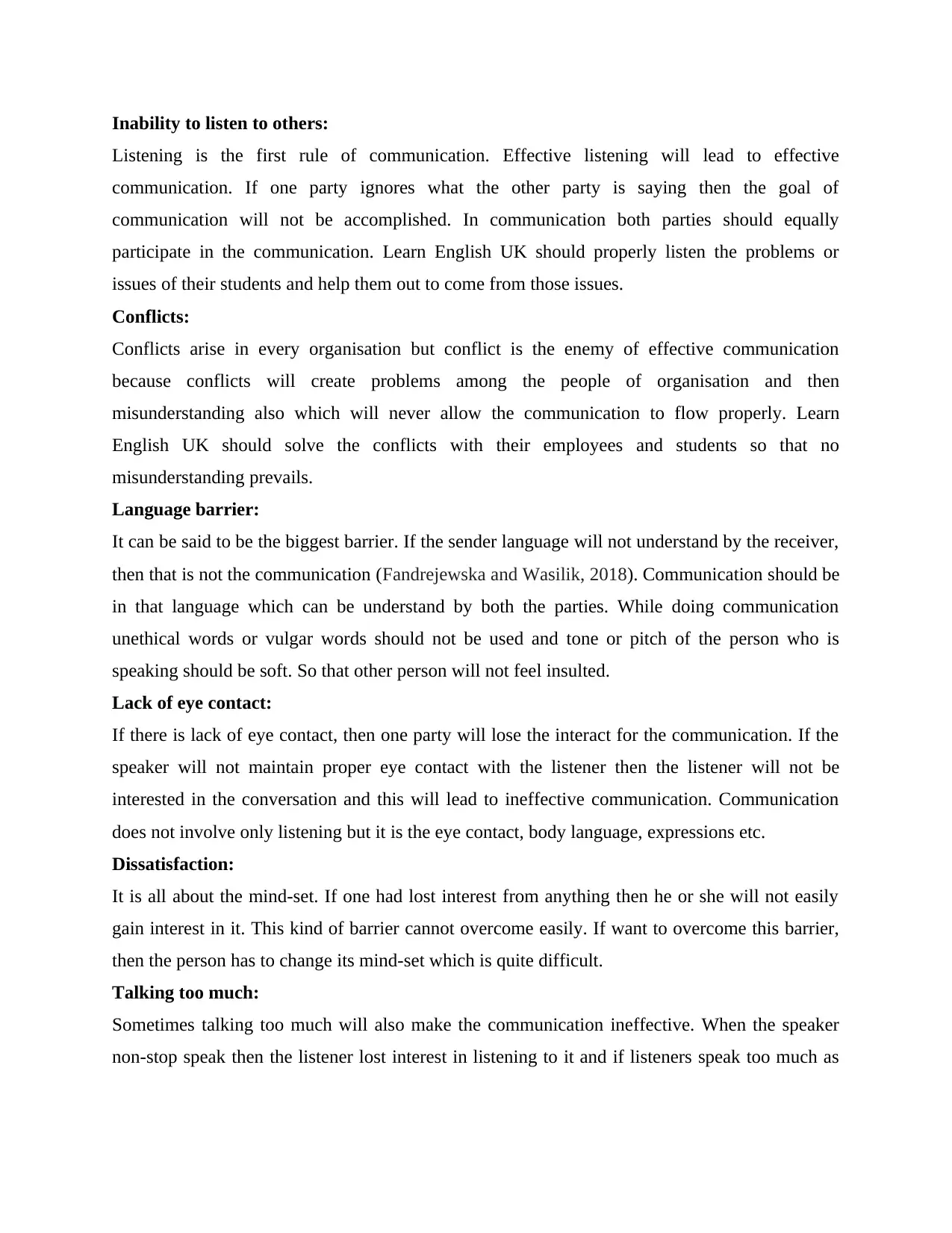
Inability to listen to others:
Listening is the first rule of communication. Effective listening will lead to effective
communication. If one party ignores what the other party is saying then the goal of
communication will not be accomplished. In communication both parties should equally
participate in the communication. Learn English UK should properly listen the problems or
issues of their students and help them out to come from those issues.
Conflicts:
Conflicts arise in every organisation but conflict is the enemy of effective communication
because conflicts will create problems among the people of organisation and then
misunderstanding also which will never allow the communication to flow properly. Learn
English UK should solve the conflicts with their employees and students so that no
misunderstanding prevails.
Language barrier:
It can be said to be the biggest barrier. If the sender language will not understand by the receiver,
then that is not the communication (Fandrejewska and Wasilik, 2018). Communication should be
in that language which can be understand by both the parties. While doing communication
unethical words or vulgar words should not be used and tone or pitch of the person who is
speaking should be soft. So that other person will not feel insulted.
Lack of eye contact:
If there is lack of eye contact, then one party will lose the interact for the communication. If the
speaker will not maintain proper eye contact with the listener then the listener will not be
interested in the conversation and this will lead to ineffective communication. Communication
does not involve only listening but it is the eye contact, body language, expressions etc.
Dissatisfaction:
It is all about the mind-set. If one had lost interest from anything then he or she will not easily
gain interest in it. This kind of barrier cannot overcome easily. If want to overcome this barrier,
then the person has to change its mind-set which is quite difficult.
Talking too much:
Sometimes talking too much will also make the communication ineffective. When the speaker
non-stop speak then the listener lost interest in listening to it and if listeners speak too much as
Listening is the first rule of communication. Effective listening will lead to effective
communication. If one party ignores what the other party is saying then the goal of
communication will not be accomplished. In communication both parties should equally
participate in the communication. Learn English UK should properly listen the problems or
issues of their students and help them out to come from those issues.
Conflicts:
Conflicts arise in every organisation but conflict is the enemy of effective communication
because conflicts will create problems among the people of organisation and then
misunderstanding also which will never allow the communication to flow properly. Learn
English UK should solve the conflicts with their employees and students so that no
misunderstanding prevails.
Language barrier:
It can be said to be the biggest barrier. If the sender language will not understand by the receiver,
then that is not the communication (Fandrejewska and Wasilik, 2018). Communication should be
in that language which can be understand by both the parties. While doing communication
unethical words or vulgar words should not be used and tone or pitch of the person who is
speaking should be soft. So that other person will not feel insulted.
Lack of eye contact:
If there is lack of eye contact, then one party will lose the interact for the communication. If the
speaker will not maintain proper eye contact with the listener then the listener will not be
interested in the conversation and this will lead to ineffective communication. Communication
does not involve only listening but it is the eye contact, body language, expressions etc.
Dissatisfaction:
It is all about the mind-set. If one had lost interest from anything then he or she will not easily
gain interest in it. This kind of barrier cannot overcome easily. If want to overcome this barrier,
then the person has to change its mind-set which is quite difficult.
Talking too much:
Sometimes talking too much will also make the communication ineffective. When the speaker
non-stop speak then the listener lost interest in listening to it and if listeners speak too much as
Paraphrase This Document
Need a fresh take? Get an instant paraphrase of this document with our AI Paraphraser
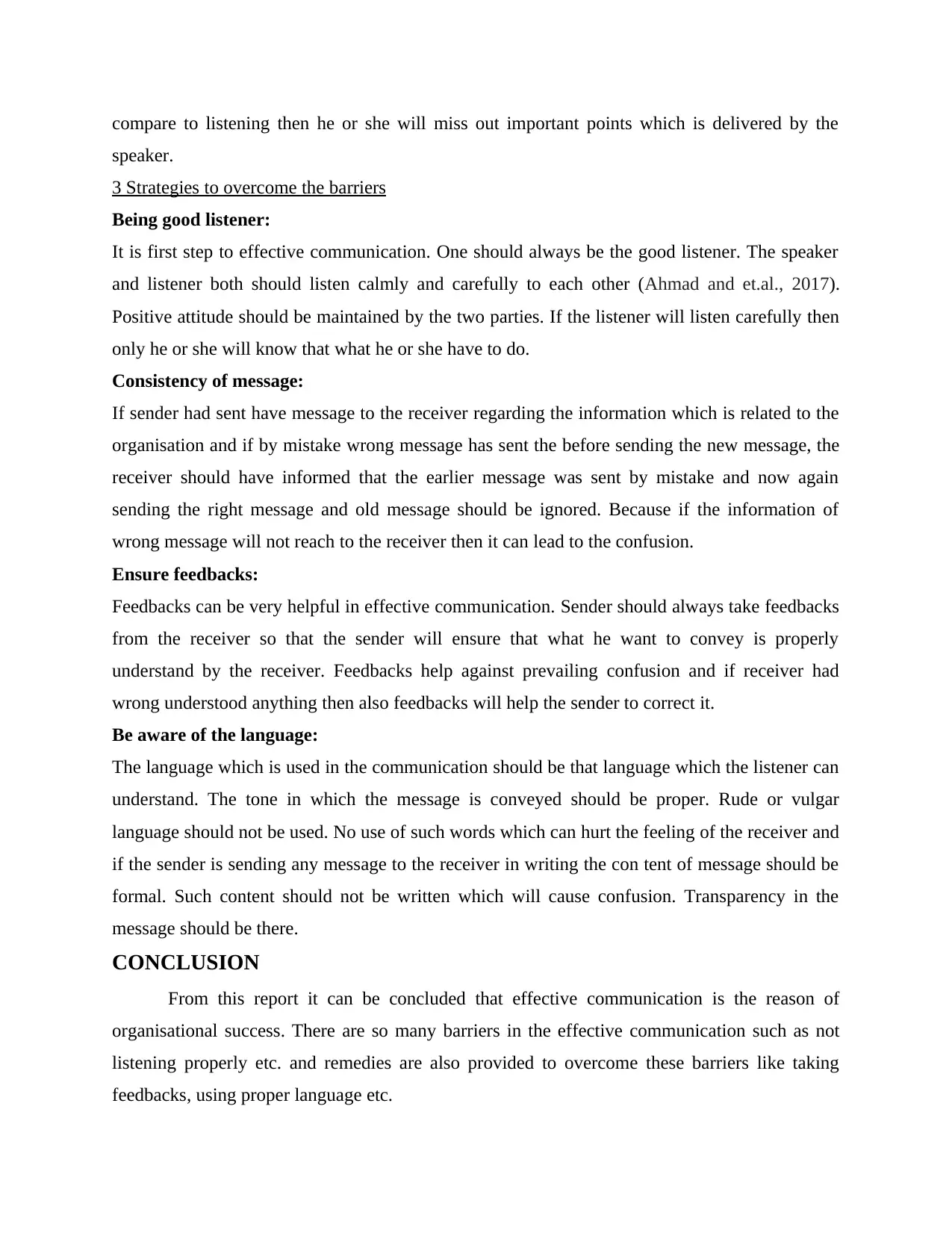
compare to listening then he or she will miss out important points which is delivered by the
speaker.
3 Strategies to overcome the barriers
Being good listener:
It is first step to effective communication. One should always be the good listener. The speaker
and listener both should listen calmly and carefully to each other (Ahmad and et.al., 2017).
Positive attitude should be maintained by the two parties. If the listener will listen carefully then
only he or she will know that what he or she have to do.
Consistency of message:
If sender had sent have message to the receiver regarding the information which is related to the
organisation and if by mistake wrong message has sent the before sending the new message, the
receiver should have informed that the earlier message was sent by mistake and now again
sending the right message and old message should be ignored. Because if the information of
wrong message will not reach to the receiver then it can lead to the confusion.
Ensure feedbacks:
Feedbacks can be very helpful in effective communication. Sender should always take feedbacks
from the receiver so that the sender will ensure that what he want to convey is properly
understand by the receiver. Feedbacks help against prevailing confusion and if receiver had
wrong understood anything then also feedbacks will help the sender to correct it.
Be aware of the language:
The language which is used in the communication should be that language which the listener can
understand. The tone in which the message is conveyed should be proper. Rude or vulgar
language should not be used. No use of such words which can hurt the feeling of the receiver and
if the sender is sending any message to the receiver in writing the con tent of message should be
formal. Such content should not be written which will cause confusion. Transparency in the
message should be there.
CONCLUSION
From this report it can be concluded that effective communication is the reason of
organisational success. There are so many barriers in the effective communication such as not
listening properly etc. and remedies are also provided to overcome these barriers like taking
feedbacks, using proper language etc.
speaker.
3 Strategies to overcome the barriers
Being good listener:
It is first step to effective communication. One should always be the good listener. The speaker
and listener both should listen calmly and carefully to each other (Ahmad and et.al., 2017).
Positive attitude should be maintained by the two parties. If the listener will listen carefully then
only he or she will know that what he or she have to do.
Consistency of message:
If sender had sent have message to the receiver regarding the information which is related to the
organisation and if by mistake wrong message has sent the before sending the new message, the
receiver should have informed that the earlier message was sent by mistake and now again
sending the right message and old message should be ignored. Because if the information of
wrong message will not reach to the receiver then it can lead to the confusion.
Ensure feedbacks:
Feedbacks can be very helpful in effective communication. Sender should always take feedbacks
from the receiver so that the sender will ensure that what he want to convey is properly
understand by the receiver. Feedbacks help against prevailing confusion and if receiver had
wrong understood anything then also feedbacks will help the sender to correct it.
Be aware of the language:
The language which is used in the communication should be that language which the listener can
understand. The tone in which the message is conveyed should be proper. Rude or vulgar
language should not be used. No use of such words which can hurt the feeling of the receiver and
if the sender is sending any message to the receiver in writing the con tent of message should be
formal. Such content should not be written which will cause confusion. Transparency in the
message should be there.
CONCLUSION
From this report it can be concluded that effective communication is the reason of
organisational success. There are so many barriers in the effective communication such as not
listening properly etc. and remedies are also provided to overcome these barriers like taking
feedbacks, using proper language etc.

⊘ This is a preview!⊘
Do you want full access?
Subscribe today to unlock all pages.

Trusted by 1+ million students worldwide
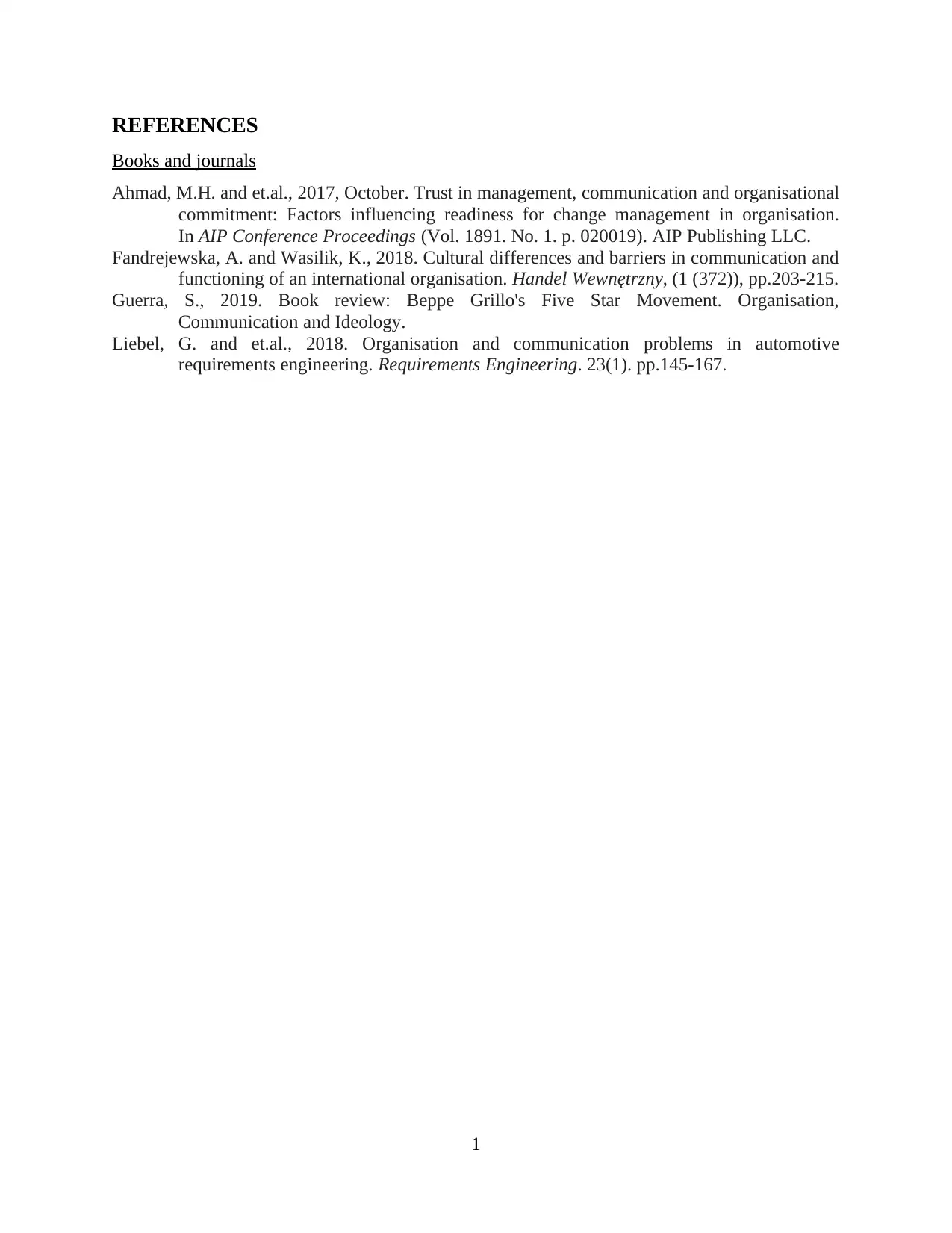
REFERENCES
Books and journals
Ahmad, M.H. and et.al., 2017, October. Trust in management, communication and organisational
commitment: Factors influencing readiness for change management in organisation.
In AIP Conference Proceedings (Vol. 1891. No. 1. p. 020019). AIP Publishing LLC.
Fandrejewska, A. and Wasilik, K., 2018. Cultural differences and barriers in communication and
functioning of an international organisation. Handel Wewnętrzny, (1 (372)), pp.203-215.
Guerra, S., 2019. Book review: Beppe Grillo's Five Star Movement. Organisation,
Communication and Ideology.
Liebel, G. and et.al., 2018. Organisation and communication problems in automotive
requirements engineering. Requirements Engineering. 23(1). pp.145-167.
1
Books and journals
Ahmad, M.H. and et.al., 2017, October. Trust in management, communication and organisational
commitment: Factors influencing readiness for change management in organisation.
In AIP Conference Proceedings (Vol. 1891. No. 1. p. 020019). AIP Publishing LLC.
Fandrejewska, A. and Wasilik, K., 2018. Cultural differences and barriers in communication and
functioning of an international organisation. Handel Wewnętrzny, (1 (372)), pp.203-215.
Guerra, S., 2019. Book review: Beppe Grillo's Five Star Movement. Organisation,
Communication and Ideology.
Liebel, G. and et.al., 2018. Organisation and communication problems in automotive
requirements engineering. Requirements Engineering. 23(1). pp.145-167.
1
Paraphrase This Document
Need a fresh take? Get an instant paraphrase of this document with our AI Paraphraser

2
1 out of 8
Related Documents
Your All-in-One AI-Powered Toolkit for Academic Success.
+13062052269
info@desklib.com
Available 24*7 on WhatsApp / Email
![[object Object]](/_next/static/media/star-bottom.7253800d.svg)
Unlock your academic potential
Copyright © 2020–2025 A2Z Services. All Rights Reserved. Developed and managed by ZUCOL.




